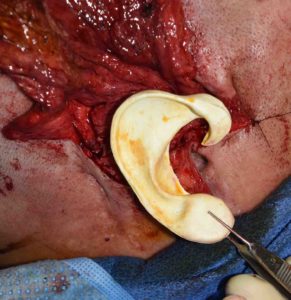Reconstruction of the lost ear requires a two-layer approach. The base la\yer is the firm and shaped framework which replaces the missing natural cartilage. The choices for the framework are either rib cartilage or synthetic framework. The second layer is the need for vascularized tissue coverage which, in cases of large amounts of ear loss, would be a temporoparietal fascial flap and a skin graft.
While there are debates about the merits of a cartilage or an implant base layer, the one huge advantage that a synthetic framework has is the avoidance of a donor site. Historically the biomaterial porous polyethylene its what has been used for synthetic ear reconstruction frameworks. It has the advantage of surface porosity and good soft tissue adherence. But it is a difficult material to shape and assemble its preformed pieces. It is also a very stiff and inflexible material of which natural ear cartilage is not.

An ear framework that is computer generated saves operative time and ensures the best potential ear shape result. It still needs to be covered by a vascularized soft tissue layer. But that need is necessary regardless of the material composition of the ear framework.
Dr. Barry Eppley
Indianapolis, Indiana


